The Magnitude of E-Commerce Today
Since e-commerce plays out within the large laissez-faire environment of the World Wide Web, there is essentially no central registry that reliably reports the magnitude of global transactions. Hence, estimates vary widely:
- US retail sales were estimated at $170bn in 2006. While Europe lagged behind, industry forecasters had reason to believe the expanded EC would surpass America by 2010 (Schifferes, 2006).
- Jupiter Media Matrix (2002) predicted the U.S. online market at just $130.3 billion in 2006 on the strength of cua mulative annual growth rate of 8.2%whichat concededly included the dot-com boom of 1997 to 1999. (see Figure 1 below) By headcount, no less than 60% of the 2.3 million small U.S. companies already had an online retail presence in 2002 even though just 16% were in the retail trade.
- More recent estimates (IBISWorld, 2009) suggested that U.S. e-commerce operators had already attained $99.5 billion in revenue, counting sales to overseas customers. This was accounted for by no less than 48,000 firms of varying size. The industry leaders were Amazon.com, Dell and eBay. E-commerce spanned many industry verticals: accessories (including footwear), electronics and appliances, furniture and home furnishings, office equipment and supplies, books and magazines, drugs, health aids and beauty aids; music and videos; travel and hospitality; toys, hobby goods, games; computer software, sporting goods; food, beer and wine.
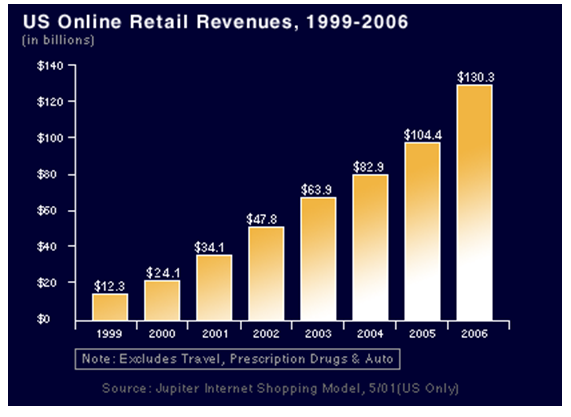
Adoption Trends in Emerging and Industrialising Economies
The United States and the original European Community members may have pioneered going into the World Wide Web, even invented the basic tools and techniques. About a decade and a half after the Internet had been popularised, however, sheer population dynamics has thrust Asia to the forefront as the continent with the greatest population having Web access either as subscribers at home, at work or simply enthusiastic about logging on from time to time in some Internet café or other (see Figure 2 overleaf).
By one estimate, close to a quarter of the world’s population already have access of some kind or another. As a percentage of the population that can go online almost at will, Internet penetration remains greatest in North America (at 74%, see Figure 3 below). Oceania (60%) stands a distant second, even accounting for the fact that this is chiefly the advanced economies of Australia and New Zealand. Europe ranks third with just under half of the population (49%) able to go online at will.
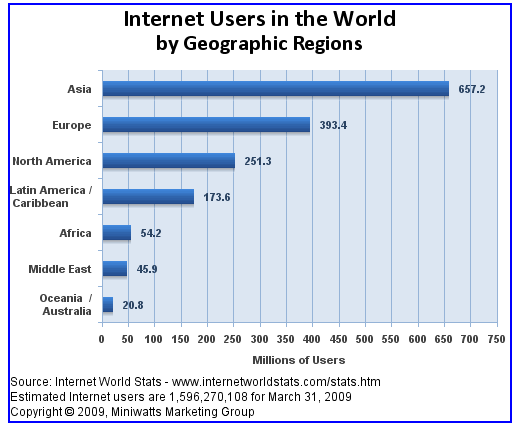
Bedevilled still by great pockets of poverty, ongoing civil strife and vestiges of anachronistic government, Asia (17.4%, Figure 3) lags below the world average in Internet penetration and thus stands in the fourth or fifth rank of the world’s geographic regions. In fact, the sparsely-populated and more tumultuous but oil-rich Middle East has markedly better Net access. And Central and South America boast twice the Internet penetration that Asia has.
As home to two of the most populous nations, however, Asia has an aggregate “wired” headcount well on its way to accounting for half the global population that can be reached via the Internet (see Figure 4 overleaf). This bodes well for attaining the critical mass of online vendors and shoppers that will make e-commerce a self-sustaining cycle.
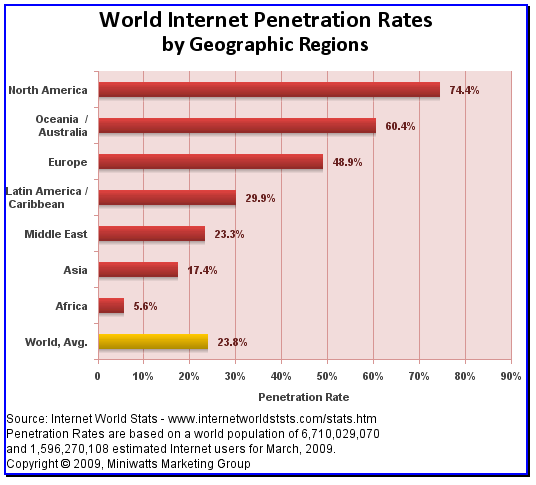

And close to half of Asia’s estimated population of Internet users are in China (45.8%, excluding the Hong Kong and Macau SAR’s, see Table 1 below). Indeed, the massive population overhang and burgeoning per-capita income that is China puts the country leagues ahead in the Internet market stakes with close to 300 million users according to official estimates (Figure 5).

Malaysia stands eighth among Asian countries by Internet headcount, in the fourth rank along with Pakistan, Republic of China/Taiwan and other ASEAN members. Some of the explanations for variable progress towards building an Internet marketplace are evident in a comparison of population bases (see Table 1).
In fact, Malaysia (62.8% reported Internet penetration) ranks sixth in Asia, right behind industrial powerhouses Japan (73.8%) and South Korea (76.1%), and the three “export tigers” of East Asia: HK (69.5%), Singapore (67.4%) and ROC/Taiwan (66.1%, see Appendix A for ranked standings).
Table 1: Asian Internet Populations, Ranked by Headcount.
Restricted market base must be counted the principal reason for the comparatively modest standing of Malaysia among Asian Internet markets. At an estimated population of 25.3 million in 2008, the closest benchmark for market base is ROC/Taiwan: 22.9 million people, marginally better Internet penetration (66.1%) and about 15.1 million Internet users.
Headcount is, of course, by no means the sole or even most important determinant of market size. Nepal has a larger population base than Malaysia and Sri Lanka itself is only slightly less populous. However, markedly lower per-capita incomes ensure marginal Internet penetration of 3.7% for Sri Lanka (ranked 189th in the world with a purchasing-power-parity per-capita income [PCI] of just $1,040 per annum, World Bank, 2008) and Web access of only 1.4% for Nepal (rank: 136th, PCI: $4,210). On this basis, Malaysians are three times wealthier (PCI: $13,470) and Taiwanese more than twice as well-off ($30,100. ranked 34th globally).
Neither is income the sole determinant of Internet population count. Consumerism, an affinity for Western cultures, facility in English, a propensity for online gaming and social networking all help explain why the far less well-off Philippines (PCI: $3,730) boasts an Internet-savvy population almost as large as Malaysia’s.
Neighbouring Singapore is another case in point of the constraint that market size can pose. Laying down the cables that constitute the distribution backbone of the Internet may be essential and doubtless, so are per-capita income and the sophistication of the population. However, market size also counts for a great deal. Singapore claims to have been the global pioneer in rolling out ADSL lines as early as 1997. This was followed by cable-delivered Internet in 1999.
Today, government boasts that the population has 99% connectivity (access), which is not to say that everyone who has Internet jacks in their government flats is inclined to buy the necessary equipment and go online. Active Internet usage amounted to 67.4% of the Singapore population as of 2008, nearly double the 37% penetration rate in 2000. To date, according to IDC, B2B transactions account for the lion’s share (80%) of e-commerce activity in 2007 (Avny, 2009). Nonetheless, Singapore ranks five places below Malaysia by Internet headcount. And relative to that island-state, South Korea, Japan and Hong Kong have forged ahead in total broadband subscriber headcount.
Reviewing the recent record for Malaysia itself, data compiled by the International Telecommunications Union and the Malaysian Communications and Multimedia Commission suggest that penetration nearly quadrupled and the market base of users expanded rapidly since 2000.
Table 2.
Theoretical Models
Even when hurdles in respect of electricity and telephone infrastructure networks have been surpassed, the thoughtful observer finds acceptance gaps that have little to do with total cost of ownership (TCO). Among the proposed frameworks are the theories of innovation adoption/diffusion, rational acceptance, reasoned action (TRA), planned behaviour (TPB), technology acceptance model (TAM), facilitators/inhibitors and perceived characteristics of innovating (PCI) theories.
Rogers (1995) may well have been the first to transpose the sociological and anthropological constructions of innovation (Rogers 1976, 1983) to the then-embryonic field of e-commerce. Strategists in mainstream marketing (major media advertising, bricks-and-mortar sales outlets) accordingly sought to measure and profile the innovators that Rogers claimed were well-off, highly educated, adventurous, socially active, coped well with uncertainty and risk, typically opinion leaders (Summers, 1970) in their own communities, evince superb empathy, and demonstrate a high need for achievement.
Others who maintained that innovation diffuses unevenly, that the phenomenon of people and enterprises accepting innovation at different rates applied to online marketing included Wang (2001). After all, e-commerce has by no means reached the saturation point yet even in the most advanced markets (Katz and Aspden, 1997; Agarwal and Prasad, 1998; Kehoe et al., 1999; Lohse, Bellman and Johnson, 1999). Hence, industrialising but emergent economies like Malaysia can be expected to lag.
A second framework, “facilitators and inhibitors,” seemed particularly apt for the situation of disadvantaged nations. Investigations into the state of Internet penetration and e-commerce readiness in a range of developing countries – Mongolia (Enns and Huff, 1999), Latin America (Davis, 1999), Malaysia (Mukti, 2000), the Ukraine (Jennex and Amoroso, 2002), and Costa Rica (Travica, 2002) – had done little more than affirm just how much Third World nations generally lagged behind the industrialized West in infrastructure and other development indicators. Nonetheless, Kapurubandara and Lawson (2006) sought to synthesize a model based on Internal and External Barriers.
The former refer to organisational constraints while the latter bespeak social, legal, cultural, infrastructure (technological, economic), political and cultural impediments. Obviously, leadership, organizational development and strategic management can resolve internal barriers but the model looks to government as the primary force that must break down legal, political, and other constraints.
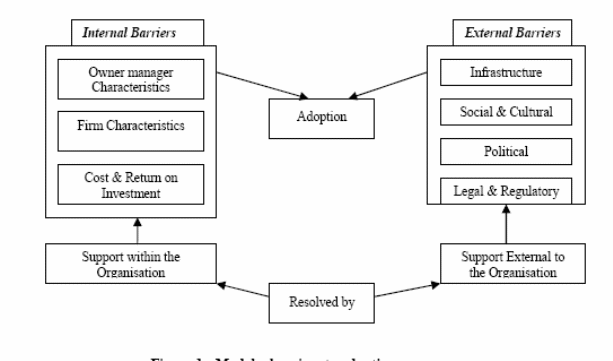
Deriving as it does from a fairly recent synthesis of research in developing countries, the framework suggested by Kapurubandara and Lawson pragmatically demonstrates that there are relatively inflexible constraints but also plentiful opportunities for change management and action on both sides of the Internal/External divide.
Yet a third theoretical framework, perceived characteristics of innovation (PCI), shares with the “barriers” typology a focus on internal determinants. In formulating PCI, Moore and Benbasat (1991) used the Rogers (1995) theory of innovation diffusion as a springboard for asserting that every decision to embrace new technology depends greatly on such characteristics as: reliability (whether the result can be replicated and demonstrated), ease of use, visibility (awareness), image or reputation, “voluntariness”, whether the innovation will create competitive advantage, compatibility and acceptable costs to try.
Pertinent to the PCI view of ICT diffusion and acceptance is the assumption that technology already well received in another culture does not necessarily cross borders smoothly or painlessly. The same analogy applies to e-commerce. Writing in 2008, Poong and Eze observed that e-commerce remained very much a novelty to the Malaysian public, the claim of two-thirds Internet penetration notwithstanding.
Being completely focused on gaining visibility into acceptance of information systems (Davis, Bagozzi, and Warshaw, 1989), the technology acceptance model (TAM) would appear even more pertinent to analysis of ICT diffusion in Malaysia. As originally devised by Davis (1989), TAM boasted great intuitive appeal for modelling technology adoption, i.e., behavioural intention, on perceived usefulness (PU) and perceived ease of use (PEOU). PEOU is postulated to be a determinant of PU that is in turn the antecedent for behavioural intention. Empirically-minded researchers valued the parsimony of the TAM model.
However, one must bear in mind that the “information revolution” was still in the DOS and IBM PC/AT 486 stage at the time Davis conceptualised TAM. Going online then meant logging onto DOS-based bulletin board systems. Today, the sheer profusion of Web technologies (see Fig. 7 below) has enriched consumer experience immeasurably but also created technological complexity light years beyond what was possible in 1989.

Scale and Applicability to SME’s
Even in the more advanced, best-wired economies, e-commerce remains very much in the growth phase of the “product” life cycle.
The latest update on penetration in America (AMI-Partners, 2008) estimates that nearly two-thirds of “very small businesses” (those with 1-9 employees) have already managed to put up a company Web site. Of that 63%, just over half (37%) have put in place at least rudimentary ecommerce solutions for online sales and customer service. Among “micro-enterprises” that are home-based and have a PC, more than half (53%) do not currently plan to put up a Web site, 19% claim they are in the process of acquiring one, and less than one-third (28%) already have a Web presence. Furthermore, fully a third (37%) of commercially-located very small businesses (meaning they have a bricks and mortar outlet in a shopping centre of the city) still do not have a Web site. Such a situation means that, for emergent economies, looking to 100% as a penetration ideal is by no means realistic.
An insight into the hindrances behind full acceptance of the e-commerce model up to now is provided by an Organization for Economic Cooperation and Development (OECD) study in 2000, when e-commerce had yet to generate widespread acceptance. At that time, Panagariya (2000) reported that non-receptive businessmen in both the most industrialized and developing countries were quite simply not aware of the e-commerce business model or, having heard vaguely about what Amazon, Dell and others had pioneered, remained uncertain how selling online could possibly benefit their own enterprise. Secondly, concerns about total cost of ownership (TCO, referring both to upfront costs and ongoing costs for maintenance and hosting), where to find trained manpower, and apprehension about the security of financial transactions loomed large.
With differing emphases and prevalence, these major themes recur in developing nations and emergent economies.
Considering empirical tests of theory as applied to e-commerce adoption, there is evidence that the diffusion of innovation model as operationalised in a perceived characteristics of innovation (PCI) study instrument did explain acceptance (or rejection) of e-commerce in a comparative study of Indian, Chinese, American and Hong Kong students (Slyke, Lou and Belanger, 2004), as well as U.S. and Indian consumers (Slyke, Belanger and Sridhar, 2005). The model also accounted for inter-country variation as a question of differences in knowledge of the e-commerce bundle of technologies and benefits (awareness) and the consequent inclination towards acceptance or caution that such knowledge engenders.
Applying their Internal/External Barrier model to SME’s, Kapurubandara and Lawson (2006) maintain that businesses up to 250 employees in size can be presumed to have control over internal weaknesses even as the researchers acknowledged that owner/manager factors can be somewhat inflexible. Accordingly, an owner-manager convinced of the intangible benefits and attractive return on investment (ROI) offered by engaging in e-commerce can decisively sweep away common barriers such as lack of time, staff or resources by allocating a budget for the effort and assigning online selling high strategic priority.
On the other hand, one often-overlooked type of financial constraint is that SME’s have little elbow room for investment mistakes, a matter that the EBusiness Policy Group brought to light even among businessmen in the European Community (EBPG, 2002). This, of course, puts the premium on possessing the technical knowledge to choose from among many combinations of e-commerce systems, a problem that has, if anything, become more complex.
Other internal barriers can be true weaknesses, as when the entrepreneur or manager is himself not computer-literate or Internet-savvy (Akkeren and Cavaye, 1999). In that case, no amount of expert outsourced site development assistance can help an entrepreneur take the first infant steps to a place in the world of e-commerce.
Kapurubandara and Lawson err, however, in believing that SME’s can overcome some external barriers via clustering or syndication of expenses, facilities, and other resources. The reality is that the best that can be done is for business associations to lobby government (for incentives or duty exemptions, for example) or the utilities monopolies for power and telephone line connections where none exist. Of course, the absence of these twin utilities are crippling hindrances to e-commerce.
But it can also be argued that no SME makes the leap from old-fashioned ways of doing business to adopting an e-commerce channel overnight. There is, in all likelihood, a transition or maturation period when a small firm and its customers realize the efficiencies of, for instance, newly-installed phone and fax communications before mulling over the strategic advantages of e-commerce and advertising on the Web (Knol and Stroeken, 2001).
The case of Sri Lanka (Kapurubandara and Lawson, 2006) illustrates a situation where SME’s are already well advanced in the use of computers and the Internet but need to overcome knowledge and attitude barriers to adopting e-commerce. Enterprise size has not prevented limited liability companies, family businesses and partnerships from owning computers (100%), enabling them to communicate via email (79%) and a local area network (75.7%) rather than a “sneaker net”, and already gave vent to corporate vainglory with a website (63.2%).
Still, the lion’s share of owners/managers rationalised that (in order of prevalence) there was little support to be had from government or industry associations, that local shoppers did not know enough about e-commerce (and neither did any of their staff), that the existing legal framework did not provide sufficient incentives for venturing into e-commerce, and that government guidelines were unclear. Such pronounced dependence on government presumably owes much to the socialist democratic nature of Sri Lankan politics. In turn, the finding about shifting policies bears out the World Bank and Asian Development rating of Sri Lanka as one of the most politically unstable nations.
Internally, half of owners/managers lacked for business models to assure them that e-commerce suited almost any product/service. About as many took a dim view of incremental revenue from an online selling channel and wondered whether these would even pay for the cost of developing and maintaining an e-commerce site.
To explain the involvement of decision-maker openness to innovation, objective and perceived competitive factors, and internal characteristics of the firm, Wang (2001) conceptualized the three-level model shown in Figure 8. While this was concededly based on an exploratory study on a sample of just 19 travel agencies in Taiwan, the three-level model is an excellent paradigm of the interaction between innovation adoption and the theory of planned behaviour.
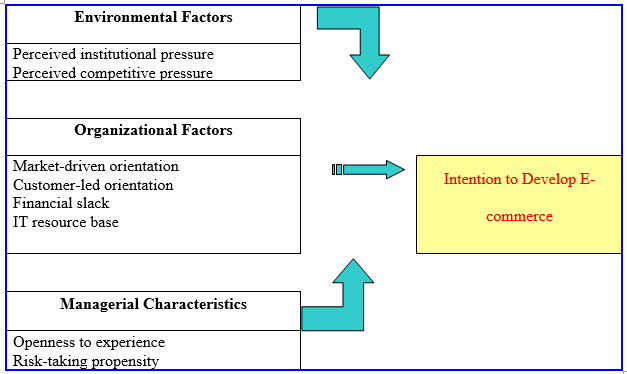
Adoption Rate by Malaysian SME’s
In fact, technology has a way of responding to market needs and leapfrogging infrastructure gaps in emergent economies. Just as more affordable handsets and mobile plans accelerated cellular phone penetration and overcame the high investment costs for landlines, so does IDC expect that the imminent availability of roomy bandwidth with WiMAX and 3G wireless technology will enable businessmen in underserved areas to connect to the Internet at affordable rates. Consequently, opined Lincoln Lee, Telecommunications research manager for IDC Malaysia, “…the increase of unique Internet users in Malaysia will create an awareness of ecommerce and drive Internet commerce spending…” (2008, 1)
References
Agarwal. R. & Prasad, J. (1998). A conceptual and operational definition of personal innovativeness in the domain of information technology. Information Systems Research, 9(2): 204-215.
Akkeren, J. & Cavaye, A.L.M. (1999). Proceedings of the 10th Australasian Conference on Information Systems: Factors Affecting Entry-Level Internet Technology Adoption by Small Business in Australia: An Empirical Study. Wellington, New Zealand.
Alam, S. S., Ishak, N. A., Khatibi, A. & Ahsan, N. (2008). Proceedings of the 5th SMEs in Global Economy Conference: The Effect of Perceived Characteristics of Innovating on ICT Adoption in the SMEs in Malaysia. 23-36.
AMI-Partners (2008). Microsoft Office Live small business: A pulse check. Business Wire.
Anigan, G. (1999). Views on electronic commerce. International Trade Forum, 2, 23–27.
Asia Foundation (2002). Survey on E-Commerce implementation in the SME sector of Sri Lanka. SLBDC.
Avny (2009). Internet and e-commerce industry in Singapore. Web.
Becker, A. (2008). Electronic commerce: Concepts, methodologies, tools and applications. Hertfordshire: Idea Group.
Bingi, P., Mir, A. and J. Khamalah. (2000). The challenges facing global ecommerce. Information Systems Management, 17(4), 26–35.
Davis, F.D. (1989). Perceived usefulness, perceived ease of use, and user acceptance of information technology. MIS Quarterly, 13(3), 319-340.
Davis, F.D., Bagozzi, R.P., & Warshaw, P.R. (1989) User acceptance of computer technology: A comparison of two theoretical models. Management Science, 35(8), 982- 1003.
Davis, C.H. (1999). The rapid emergence of electronic commerce in a developing region: The case of Spanish-speaking Latin America. Journal of Global Information Technology Management, 2(3), 25–40.
EBPG (2002). eEurope go digital: Benchmarking national and regional e-business policies for SMEs. Final report of the EBusiness Policy Group.
Elkin, N. (2001). Online privacy and security in Latin America. eMarketer.com and Economist Intelligence Unit – Global Technology Forum. Web.
El-Nawawy, M.A. & M.M. Ismail. (1999). Proceedings of the 9th Annual Conference of the Internet Society, INET 99: Overcoming Deterrents and Impediments to Electronic Commerce in Light of Globalisation: The Case of Egypt. San Jose, California, USA.
Enns, H.G., & Huff, S.L. (1999). Information technology implementation in developing countries: Advent of the Internet in Mongolia. Journal of Global Information Technology Management, 2(3), 5–24.
Greenspan, A. (2000). The revolution in information technology. Remarks Before the Boston College Conference on the New Economy, Boston, Massachusetts. Web.
IBISWorld (2009). eCommerce & online auctions: U.S. industry report. Web.
IDC (2008). Malaysia Internet and eCommerce 2008-2012 forecast and analysis. Web.
Internet World Stats (2008). (Malaysia) Internet usage stats and marketing report. Web.
Jennex, M.E. & Amoroso, D.L. (2002). e-Business and technology issues for developing economies: A Ukraine case study. Electronic Journal of Information Systems in Developing Countries, 10(5), 1–14.
Jupiter Media Matrix (2002). Market forecast report. p. 6. Web.
Kapurubandara, M. & Lawson, R. (2006). Barriers to adopting ICT and e-commerce with SMEs in developing countries: An exploratory study in Sri Lanka. CollECTeR.
Kehoe, C., Pitkow, J. Sutton, K., Agarwal, G., & Rogers, J. D. (1999). Results of GVU’s tenth WWW user survey. Georgia Institute of Technology. Web.
van Ketel, M. & Nelson, T. D. (2008). E-commerce. SearchCIO. Web.
Knol, W.H.C. & Stroeken, J.H.M. (2001). The diffusion and adoption of information technology in small- and medium –sized enterprises through IT Scenarios. Technology Analysis & Strategic Management, 13(2), 227-246.
Lohse, G. L. Bellman, S., & Johnson, E. J. (1999). Consumer buying behaviour on the Internet: Findings from panel data. Web.
Moore, G.C., and Benbasat, I. (1991). Development of an instrument to measure the perceptions of adopting an information technology innovation. Information Systems Research, 2(3), 192-222.
Mukti, N.A. (2000). Barriers to putting businesses on the Internet in Malaysia. Electronic Journal of Information Systems in Developing Countries, 2(6), 1–6.
Panagariya, A. (2000). E-Commerce, WTO, and developing countries. World Economy, 23(8), 959–979.
Peter, I. (2004). So, who really did invent the Internet? The Internet History Project. Web.
Poong, Y. S. & Eze, U. C. (2008). TAM vs. PCI: An analysis on the theoretical model parsimony and robustness across cultures. Communications of the IBIMA, 1, 198-201.
Rogers, E. M. (1995). Diffusion of innovations (4th ed.). New York: The Free Press.
Roy, S. (2008) Origin of the internet: Purpose and evolution. Suite101. Web.
Schifferes, S. (2006). How the internet transformed business. BBC News. Web.
Schmid, B., Stanoevska-Slabeva, K. & Tschammer, V. (2001). Towards the ESociety: E-Commerce, E-Business, E-Government. Zurich, Switzerland.
Slyke, C.V., Belanger, F., & Sridhar, V. (2005). A comparison of American and Indian consumers’perceptions of electronic commerce. Information Resources Management Journal, 18(2), 2005, 24-40.
Slyke, C.V., Lou, H., & Belanger, F. (2004). Proceedings of the Southern Association for Information Systems: The influence of culture on consumer-oriented electronic commerce adoption.
Summers, J. O. (1970). Generalized change agents and innovativeness. Journal of Marketing Research: 313-316.
Travica, B. (2002). Diffusion of electronic commerce in developing countries: The case of Costa Rica. Journal of Global Information Technology Management, 5(1), 4–24.
Wang, S. C. (2001). Individual/organizational characteristics and intention to adopt e-commerce: A study based on innovation adoption theory (Doctoral dissertation, The Chinese University of Hong Kong, 195 pages; AAT 3025854.
World Bank (2008). Gross national income per capita 2007, Atlas method and PPP. World Development Indicators database. Web.
World Bank (2004). Trade research – Unstable politics hurt Sri Lanka investment-lenders. Web.
Appendices
Internet Population, Selected Asian Markets
Table 3.